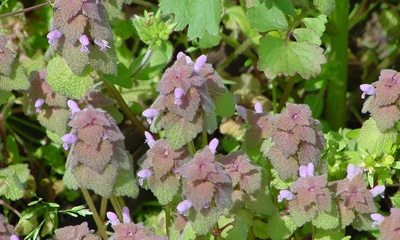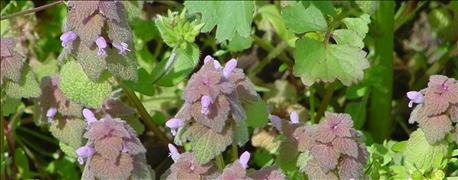
Someone asked Betsy Bower if winter annual weeds are worth taking out with herbicides in the fall. Bower, an agronomist with Ceres Solutions who works primarily in west-central Indiana, didn’t hesitate. She is also an Indiana Certified Crop Adviser.
“My gosh, yes!” she responded. “One of our most problematic weeds in no-till is marestail. It emerges in the fall and early spring.”
Corn Illustrated 9/26: 6 factors affect how quickly corn dries down
Marestail is a weed that can be tough to control in no-till soybeans, especially if it starts to bolt before the spring burndown application, she notes.
Target marestail

KEEP COLOR IN FLOWERBED: You don’t want this kind of color in crop fields. Purple deadnettle is one of the winter annuals you can get a jump on with fall herbicide applications. (Photo courtesy of Bill Johnson, Purdue University Extension weed control specialist)
“We can really improve control if we apply a fall burndown,” Bower says. “The burndown needs to have a product containing dicamba plus glyphosate. A 2,4-D product can also be added, as well as a residual product like simazine in front of corn or metribuzin in front of soybeans.”
Brand names of possible products and complete weed control strategies for marestail and other fall annuals are covered in the 2016 Ohio, Indiana and Illinois Weed Control Guide prepared by the Extension weed control specialists in those three states.
Dicamba, glyphosate and 2,4-D will control the marestail, Bower notes. That’s true as long as the marestail is not glyphosate-resistant. “It’s the dicamba that provides the residual control of marestail in the spring to improve the control of the spring burndown,” she says.
Chickweed problem
Dan Ritter agrees that fall is a great time to begin controlling marestail. He also likes to take care of chickweed in the fall. He’s an agronomist with Brodbeck Seeds based in Marion and also a CCA.
“One of my biggest issues with chickweed is that it can interfere with proper planter operation,” Ritter says. He refers to the Ohio, Indiana and Illinois Weed Control Guide for recommendations.
“Products to consider if going to soybeans are CanopyEX, Cloak, Fallout or Basis,” he says. “If you’re going to corn, consider simazine, or Basis or Harrow mixed with 2,4-D.”
If you want a little more flexibility with crops next spring, Ritter mentions considering Autumn or metribuzin or 2,4-D and glyphosate. “You could apply as late as December with some of the soil-applied products," he says. “Be sure to read and follow label directions.”
Cover crop dilemma
Suppose you are concerned about winter annual weeds, but you also want to grow a cover crop in some fields. Are they mutually exclusive? Not necessarily, Bower answers.
She notes that a cereal rye cover crop can be great competition for winter annual weeds. If you haven’t seeded annual rye yet, most farmers who have grown it say you can still seed cereal rye in early November successfully in most years.
Corn Illustrated 9/19: No-tiller's success in farming has nothing to do with tillage system
“Consider applying a burndown in front of seeding cereal rye, or consider a dicamba-based application to the cereal rye cover crop once it emerges,” Bower says. “The goal would be controlling winter annuals and marestail to allow cereal rye to compete with weeds even better.”
About the Author(s)
You May Also Like




